TiO2-Modified Montmorillonite-Supported Porous Carbon-Immobilized Pd Species Nanocomposite as an Efficient Catalyst for Sonogashira Reactions
Abstract
1. Introduction
2. Results and Discussion
2.1. Microstructure of the Catalytic Nanocomposites
2.2. Positron Annihilation Characteristics of the Catalytic Nanocomposites
2.3. Performances of the Catalytic Nanocomposites Applied in Sonogashira Reactions
3. Materials and Methods
4. Conclusions
Supplementary Materials
Author Contributions
Funding
Institutional Review Board Statement
Informed Consent Statement
Data Availability Statement
Conflicts of Interest
Sample Availability
References
- Pagliaro, M.; Pandarus, V.; Ciriminna, B.R.F.; Cara, P.D. Heterogeneous versus homogeneous palladium catalysts for cross-coupling reactions. ChemCatChem 2012, 4, 432–445. [Google Scholar] [CrossRef]
- Muimhneacháin, E.Ó.; McGlacken, G.P. Pd (0) nanoparticles (NPs) as catalysts in cross-coupling reactions and the homogeneous vs. heterogeneous debate. In Organometallic Chemistry; The Royal Society of Chemistry: London, UK, 2015; pp. 33–53. [Google Scholar]
- Hussain, I.; Capricho, J.; Yawer, M.A. Synthesis of biaryls via ligand-free Suzuki-Miyaura cross-coupling reactions: A review of homogeneous and heterogeneous catalytic developments. Adv. Syn. Catal. 2016, 358, 3320–3349. [Google Scholar] [CrossRef]
- Gärtner, D.; Sandl, S.; von Wangelin, A.J. Homogeneous vs. heterogeneous: Mechanistic insights into iron group metal-catalyzed reductions from poisoning experiments. Catal. Sci. Technol. 2020, 10, 3502–3514. [Google Scholar] [CrossRef]
- Zhao, M.; Wu, Y.; Cao, J.-P. Carbon-based material-supported palladium nanocatalysts in coupling reactions: Discussion on their stability and heterogeneity. Appl. Organomet. Chem. 2020, 34, e5539. [Google Scholar] [CrossRef]
- Bej, A.; Ghosh, K.; Sarkar, A.; Knight, D.W. Palladium nanoparticles in the catalysis of coupling reactions. RSC Adv. 2016, 6, 11446–11453. [Google Scholar] [CrossRef]
- Liu, X.; Astruc, D. Development of the applications of palladium on charcoal in organic synthesis. Adv. Synth. Catal. 2018, 360, 3426–3459. [Google Scholar] [CrossRef]
- Díaz-Sánchez, M.; Díaz-García, D.; Prashar, S.; Gómez-Ruiz, S. Palladium nanoparticles supported on silica, alumina or titania: Greener alternatives for Suzuki–Miyaura and other C–C coupling reactions. Environ. Chem. Lett. 2019, 17, 1585–1602. [Google Scholar] [CrossRef]
- Cartagenova, D.; Bachmann, S.; Püntener, K.; Scalone, M.; Newton, M.A.; Esteves, F.A.P.; Rohrbach, T.; Zimmermann, P.P.; van Bokhoven, J.A.; Ranocchiari, M. Highly selective Suzuki reaction catalysed by a molecular Pd–P-MOF catalyst under mild conditions: Role of ligands and palladium speciation. Catal. Sci. Technol. 2022, 12, 954–961. [Google Scholar] [CrossRef]
- Okumura, K.; Iiyoshi, H. Spontaneous formation and catalysis of highly dispersed Pd0 on* BEA zeolite. Microporous Mesoporous Mater. 2021, 325, 111336. [Google Scholar] [CrossRef]
- Gawande, M.B.; Branco, P.S.; Varma, R.S. Nano-magnetite (Fe3O4) as a support for recyclable catalysts in the development of sustainable methodologies. Chem. Soc. Rev. 2013, 42, 3371–3393. [Google Scholar] [CrossRef]
- Sadjadi, S.; Heravi, M.M.; Kazemi, S.S. Ionic liquid decorated chitosan hybridized with clay: A novel support for immobilizing Pd nanoparticles. Carbohydr. Polym. 2018, 200, 183–190. [Google Scholar] [CrossRef]
- Wang, K.; Cui, W.; Bian, Z.; Liu, Y.; Jiang, S.; Zhou, Y.; Wang, J. Size and stability modulation of Pd nanoparticles on porous hypercrosslinked ionic polymer for heterogeneous aerobic oxidative coupling of diaryl ether. Appl. Catal. B Environ. 2021, 281, 119425. [Google Scholar] [CrossRef]
- Silva, T.L.; Ronix, A.; Pezoti, O.; Souza, L.S.; Leandro, P.K.; Bedin, K.C.; Beltrame, K.K.; Cazetta, A.L.; Almeida, V.C. Mesoporous activated carbon from industrial laundry sewage sludge: Adsorption studies of reactive dye Remazol Brilliant Blue R. Chem. Eng. J. 2016, 303, 467–476. [Google Scholar] [CrossRef]
- Xu, J.; Liu, Y.; Tao, F.; Sun, Y. Kinetics and reaction pathway of Aroclor 1254 removal by novel bimetallic catalysts supported on activated carbon. Sci. Total Environ. 2019, 651, 749–755. [Google Scholar] [CrossRef]
- Zeng, M.; Wang, Y.; Liu, Q.; Yuan, X.; Feng, R.; Yang, Z.; Qi, C. N-doped mesoporous carbons supported palladium catalysts prepared from chitosan/silica/palladium gel beads. Int. J. Biol. Macromol. 2016, 89, 449–455. [Google Scholar] [CrossRef]
- Yang, S.; Chen, Y.; Huang, S.; Deng, L.; Wu, Y.; Zheng, X.; Omonov, S.; Zeng, M. Gelatin-pyrolyzed mesoporous N-doped carbon supported Pd as high-performance catalysts for aqueous Heck reactions. Appl. Organomet. Chem. 2021, 35, e6285. [Google Scholar] [CrossRef]
- Xu, M.; Zhao, J.; Shu, G.; Zheng, X.; Liu, Q.; Wang, Y.; Zeng, M. One-pot carbonization of chitosan/P123/PdCl2 blend hydrogel membranes to N-doped carbon supported Pd catalytic composites for Ullmann reactions. Int. J. Biol. Macromol. 2019, 125, 213–220. [Google Scholar] [CrossRef]
- Chen, X.Y.; Chen, C.; Zhang, Z.J.; Xie, D.H. Gelatin-derived nitrogen-doped porous carbon via a dual-template carbonization method for high performance supercapacitors. J. Mater. Chem. A 2013, 1, 10903–10911. [Google Scholar] [CrossRef]
- Zhao, X.; Tuo, B.; Long, S.; Song, X.; Wan, L.; Xiang, H. Study on adsorption of Cd2+ by Ti-pillared montmorillonite-mixed activated carbon. Micro Nano Lett. 2021, 16, 304–312. [Google Scholar] [CrossRef]
- Ikeue, K.; Mizukami, S.; Kuroda, A.; Hamada, S.; Hongo, A.; Masato, M. Noble-metal-containing nanoporous carbon synthesized within the interlayer space of montmorillonite and its catalytic property. Appl. Catal. Gen. 2008, 351, 68–74. [Google Scholar] [CrossRef]
- Fan, X.; Yu, C.; Yang, J.; Ling, Z.; Hu, C.; Zhang, M.; Qiu, J. A layered-nanospace-confinement strategy for the synthesis of two-dimensional porous carbon nanosheets for high-rate performance supercapacitors. Adv. Energy Mater. 2015, 5, 1401761. [Google Scholar] [CrossRef]
- Zeng, M.; Yang, S.; Chen, Y.; Xu, M.; Zhao, J.; Zhang, T.; Sun, K.; Yang, Z.; Zhang, P.; Cao, X.; et al. Porous chitosan-derived activated N-doped carbon-supported Pd nanoparticles encaged in Al, Fe pillared montmorillonite as novel heterogeneous catalysts. Appl. Clay Sci. 2022, 224, 106520. [Google Scholar] [CrossRef]
- Slaný, M.; Jankovič, L.; Madejová, J. Structural characterization of organo-montmorillonites prepared from a series of primary alkylamines salts: Mid-IR and near-IR study. Appl. Clay Sci. 2019, 176, 11–20. [Google Scholar] [CrossRef]
- Yin, J.; Pei, M.; He, Y.; Du, Y.; Guo, W.; Wang, L. Hydrothermal and activated synthesis of adsorbent montmorillonite supported porous carbon nanospheres for removal of methylene blue from waste water. RSC Adv. 2015, 5, 89839–89847. [Google Scholar] [CrossRef]
- Tong, D.S.; Wu, C.W.; Adebajo, M.O.; Jin, G.C.; Yu, W.H.; Ji, S.F.; Zhou, C.H. Adsorption of methylene blue from aqueous solution onto porous cellulose-derived carbon/montmorillonite nanocomposites. Appl. Clay Sci. 2018, 161, 256–264. [Google Scholar] [CrossRef]
- Ababneh, H.; Hameed, B. Chitosan-derived hydrothermally carbonized materials and its applications: A review of recent literature. Int. J. Biol. Macromol. 2021, 186, 314–327. [Google Scholar] [CrossRef]
- Ahmed, M.; Hameed, B.; Hummadi, E. Review on recent progress in chitosan/chitin-carbonaceous material composites for the adsorption of water pollutants. Carbohydr. Polym. 2020, 247, 116690. [Google Scholar] [CrossRef]
- Huang, S.; Yang, S.; Chen, Y.; Yang, Z.; Deng, L.; Wu, Y.; Zhang, T.; Feng, R.; Zeng, M. Porous carbon supported Pd catalysts derived from gelatin-based/chitosan or polyvinyl pyrrolidone/PdCl2 blends. J. Appl. Polym. Sci. 2022, 139, 52163. [Google Scholar] [CrossRef]
- Wang, Y.; Liu, Q.; Xu, M.; Shu, G.; Jiang, M.; Fei, G.; Zeng, M. Carbonization of chitosan in palladium-chitosan/montmorillonite composites to prepare novel heterogeneous catalysts for Heck reactions. J. Macromol. Sci. Part B 2017, 56, 670–681. [Google Scholar] [CrossRef]
- Gil, A.; Korili, S.A.; Trujillano, R.; Vicente, M.A. A review on characterization of pillared clays by specific techniques. Appl. Clay Sci. 2011, 53, 97–105. [Google Scholar] [CrossRef]
- Cardona, Y.; Vicente, M.A.; Korili, S.A.; Gil, A. Progress and perspectives for the use of pillared clays as adsorbents for organic compounds in aqueous solution. Rev. Chem. Eng. 2022, 38, 301–325. [Google Scholar] [CrossRef]
- Cardona, Y.; Korili, S.A.; Gil, A. Understanding the formation of Al13 and Al30 polycations to the development of microporous materials based on Al13-and Al30-PILC montmorillonites: A review. Appl. Clay Sci. 2021, 203, 105996. [Google Scholar] [CrossRef]
- Pandey, P.; Saini, V.K. Pillared interlayered clays: Sustainable materials for pollution abatement. Environ. Chem. Lett. 2019, 17, 721–727. [Google Scholar] [CrossRef]
- Rezala, H.; Khalaf, H.; Valverde, J.L.; Romero, A.; Molinari, A.; Maldotti, A. Photocatalysis with Ti-pillared clays for the oxofunctionalization of alkylaromatics by O2. Appl. Catal. Gen. 2009, 352, 234–242. [Google Scholar] [CrossRef]
- Kang, L.; Liu, H.; He, H.; Yang, C. Oxidative desulfurization of dibenzothiophene using molybdenum catalyst supported on Ti-pillared montmorillonite and separation of sulfones by filtration. Fuel 2018, 234, 1229–1237. [Google Scholar] [CrossRef]
- Chen, K.; Li, J.; Li, J.; Zhang, Y.; Wang, W. Synthesis and characterization of TiO2–montmorillonites doped with vanadium and/or carbon and their application for the photodegradation of sulphorhodamine B under UV–vis irradiation. Colloids Surf. Physicochem. Eng. Asp. 2010, 360, 47–56. [Google Scholar] [CrossRef]
- Chauhan, M.; Saini, V.K.; Suthar, S. Ti-pillared montmorillonite clay for adsorptive removal of amoxicillin, imipramine, diclofenac-sodium, and paracetamol from water. J. Hazard. Mater. 2020, 399, 122832. [Google Scholar] [CrossRef] [PubMed]
- Zheng, X.; Zhao, J.; Liu, Q.; Xu, M.; Yang, S.; Zeng, M.; Qi, C.; Cao, X.; Wang, B. Chitosan modified Ti-PILC supported PdOx catalysts for coupling reactions of aryl halides with terminal alkynes. Int. J. Biol. Macromol. 2020, 158, 67–74. [Google Scholar] [CrossRef] [PubMed]
- Hsing, J.; Kameshima, Y.; Nishimoto, S.; Miyake, M. Preparation of carbon-modified N–TiO2/montmorillonite composite with high photocatalytic activity under visible light radiation. J. Ceram. Soc. Jpn. 2018, 126, 230–235. [Google Scholar] [CrossRef]
- Wang, L.; Zhang, B.; Meng, X.; Su, D.S.; Xiao, F.-S. Hydrogenation of Biofuels with Formic Acid over a Palladium-Based Ternary Catalyst with Two Types of Active Sites. ChemSusChem 2014, 7, 1537–1541. [Google Scholar] [CrossRef]
- Chen, Y.; Yang, S.; Zhang, T.; Xu, M.; Zhao, J.; Zeng, M.; Sun, K.; Feng, R.; Yang, Z.; Zhang, P.; et al. Positron annihilation study of chitosan and its derived carbon/pillared montmorillonite clay stabilized Pd species nanocomposites. Polym. Test. 2022, 114, 107689. [Google Scholar] [CrossRef]
- Zhao, J.; Zheng, X.; Liu, Q.; Xu, M.; Yang, S.; Zeng, M. Chitosan supported Pd0 nanoparticles encaged in Al or Al-Fe pillared montmorillonite and their catalytic activities in Sonogashira coupling reactions. Appl. Clay Sci. 2020, 195, 105721. [Google Scholar] [CrossRef]
- Alonso, D.A.; Baeza, A.; Chinchilla, R.; Gómez, C.; Guillena, G.; Pastor, I.M.; Ramón, D.J. Solid-Supported Palladium Catalysts in Sonogashira reactions: Recent developments. Catalysts 2018, 8, 202. [Google Scholar] [CrossRef]
- Singha, S.; Sahoo, M.; Parida, K. Highly active Pd nanoparticles dispersed on amine functionalized layered double hydroxide for Suzuki coupling reaction. Dalton Trans. 2011, 40, 7130–7132. [Google Scholar] [CrossRef]
- Darder, M.; Colilla, M.; Ruiz-Hitzky, E. Biopolymer- clay nanocomposites based on chitosan intercalated in montmorillonite. Chem. Mater. 2003, 15, 3774–3780. [Google Scholar] [CrossRef]
- Schoonheydt, R.A.; Pinnavaia, T.; Lagaly, G.; Gangas, N. Pillared clays and pillared layered solids. Pure Appl. Chem. 1999, 71, 2367–2371. [Google Scholar] [CrossRef]
- Lagaly, G. Characterization of clays by organic compounds. Clay Miner. 1981, 16, 1–21. [Google Scholar] [CrossRef]
- Lagaly, G. Interaction of alkylamines with different types of layered compounds. Solid State Ion. 1986, 22, 43–51. [Google Scholar] [CrossRef]
- Zha, C.; Wang, W.; Lu, Y.; Zhang, L. Constructing covalent interface in rubber/clay nanocomposite by combining structural modification and interlamellar silylation of montmorillonite. ACS Appl. Mater. Interfaces 2014, 6, 18769–18779. [Google Scholar] [CrossRef] [PubMed]
- Liang, X.; Qi, F.; Liu, P.; Wei, G.; Su, X.; Ma, L.; He, H.; Lin, X.; Xi, Y.; Zhu, J.; et al. Performance of Ti-pillared montmorillonite supported Fe catalysts for toluene oxidation: The effect of Fe on catalytic activity. Appl. Clay Sci. 2016, 132, 96–104. [Google Scholar] [CrossRef]
- Bakardjieva, S.; Šubrt, J.; Štengl, V.; Dianez, M.J.; Sayagues, M.J. Photoactivity of anatase–rutile TiO2 nanocrystalline mixtures obtained by heat treatment of homogeneously precipitated anatase. Appl. Catal. B Environ. 2005, 58, 193–202. [Google Scholar] [CrossRef]
- Hayati-Ashtiani, M. Use of FTIR spectroscopy in the characterization of natural and treated nanostructured bentonites (montmorillonites). Part. Sci. Technol. 2012, 30, 553–564. [Google Scholar] [CrossRef]
- Zhang, Y.; Song, S.; Zhang, M.; Tuo, B. Preparation and characterization of titania-pillared montmorillonite. Surf. Rev. Lett. 2008, 15, 329–336. [Google Scholar] [CrossRef]
- Chen, D.; Zhu, Q.; Zhou, F.; Deng, X.; Li, F. Synthesis and photocatalytic performances of the TiO2 pillared montmorillonite. J. Hazard. Mater. 2012, 235, 186–193. [Google Scholar] [CrossRef]
- Khan, A.; Nurnabi, M.; Bala, P. Studies on thermal transformation of Na–montmorillonite–glycine intercalation compounds. J. Therm. Anal. Calorim. 2009, 96, 929–935. [Google Scholar] [CrossRef]
- Wagner, C.; Riggs, W.; Davis, L.; Moulder, J.; Muilenberg, G. Handbook of X-ray Photoelectron Spectroscopy; Perkin-Elmer Corp.: Eden Prairie, MN, USA, 1979; Volume 38. [Google Scholar]
- Ding, M.; Zuo, S.; Qi, C. Preparation and characterization of novel composite AlCr-pillared clays and preliminary investigation for benzene adsorption. Appl. Clay Sci. 2015, 115, 9–16. [Google Scholar] [CrossRef]
- Shufeng, Z.; Renxian, Z.; Chenze, Q. Synthesis and characterization of aluminum and Al/REE pillared clays and supported palladium catalysts for benzene oxidation. J. Rare Earths 2011, 29, 52–57. [Google Scholar]
- Shen, B.; Chen, J.; Yue, S. Removal of elemental mercury by titanium pillared clay impregnated with potassium iodine. Microporous Mesoporous Mater. 2015, 203, 216–223. [Google Scholar] [CrossRef]
- Zeng, M.; Zheng, X.; Wang, Y.; Shu, G.; Zhao, J.; Xu, M.; Qi, C.; Cao, X.; Wang, B. Investigation of organophilic montmorillonites supported palladium catalytic composites by combined positron annihilation lifetime spectroscopy and X-ray diffraction. Radiat. Phys. Chem. 2019, 165, 108343. [Google Scholar] [CrossRef]
- Zhao, J.; Xu, M.; Shu, G.; Yang, Z.; Liu, Q.; Zeng, M.; Qi, C.; Cao, X.; Wang, B. Positron annihilation characteristics and catalytic performances of poly (vinyl alcohol) intercalated montmorillonite supported Pd0 nanoparticles composites. Radiat. Phys. Chem. 2018, 153, 164–172. [Google Scholar] [CrossRef]
- Zheng, X.; Xu, M.; Yang, S.; Omonov, S.; Huang, S.; Zhao, J.; Ruan, H.; Zeng, M. Novel bio-inspired three-dimensional nanocomposites based on montmorillonite and chitosan. Int. J. Biol. Macromol. 2020, 165, 2702–2710. [Google Scholar] [CrossRef] [PubMed]
- Joshi, J.; Sodaye, H.; Pujari, P.; Srisaila, S.; Bajpai, M. Positron annihilation spectroscopic investigation of Al-pillared montmorillonites. Catal. Lett. 1998, 51, 109–112. [Google Scholar] [CrossRef]
- Sano, M.; Murakami, H.; Ichimura, K. Positronium in a layered-structure material: Montmorillonite. J. Radioanal. Nucl. Chem. 1999, 239, 325–328. [Google Scholar] [CrossRef]
- Tao, S. Positronium annihilation in molecular substances. J. Chem. Phys. 1972, 56, 5499–5510. [Google Scholar] [CrossRef]
- Eldrup, M.; Lightbody, D.; Sherwood, J.N. The temperature dependence of positron lifetimes in solid pivalic acid. Chem. Phys. 1981, 63, 51–58. [Google Scholar] [CrossRef]
- Consolati, G.; Natali-Sora, I.; Pelosato, R.; Quasso, F. Investigation of cation-exchanged montmorillonites by combined X-ray diffraction and positron annihilation lifetime spectroscopy. J. Appl. Phys. 2002, 91, 1928–1932. [Google Scholar] [CrossRef]
- Jasińska, B.; Kozioł, A.; Goworek, T. Void shapes and o-Ps lifetime in molecular crystals. Acta Phys. Pol. A 1999, 95, 557–561. [Google Scholar] [CrossRef]
- Tabassum, S.; Zahoor, A.F.; Ahmad, S.; Noreen, R.; Khan, S.G.; Ahmad, H. Cross-coupling reactions towards the synthesis of natural products. Mol. Divers. 2022, 26, 647–689. [Google Scholar] [CrossRef]
- Rayadurgam, J.; Sana, S.; Sasikumar, M.; Gu, Q. Palladium catalyzed C–C and C–N bond forming reactions: An update on the synthesis of pharmaceuticals from 2015–2020. Org. Chem. Front. 2021, 8, 384–414. [Google Scholar] [CrossRef]
- Hong, K.; Sajjadi, M.; Suh, J.M.; Zhang, K.; Nasrollahzadeh, M.; Jang, H.W.; Varma, R.S.; Shokouhimehr, M. Palladium nanoparticles on assorted nanostructured supports: Applications for Suzuki, Heck, and Sonogashira cross-coupling reactions. ACS Appl. Nano Mater. 2020, 3, 2070–2103. [Google Scholar] [CrossRef]
- Sun, S.; Li, H.; Xu, Z.J. Impact of surface area in evaluation of catalyst activity. Joule 2018, 2, 1024–1027. [Google Scholar] [CrossRef]
- Puskás, R.; Varga, T.; Grósz, A.; Sápi, A.; Oszkó, A.; Kukovecz, Á.; Kónya, Z. Mesoporous carbon-supported Pd nanoparticles with high specific surface area for cyclohexene hydrogenation: Outstanding catalytic activity of NaOH-treated catalysts. Surf. Sci. 2016, 648, 114–119. [Google Scholar] [CrossRef]
- Elhampour, A.; Nemati, F. Palladium nanoparticles supported on modified hollow-Fe3O4@TiO2: Catalytic activity in Heck and Sonogashira cross coupling reactions. Org. Prep. Proced. Int. 2017, 49, 443–458. [Google Scholar] [CrossRef]
- Eskandari, A.; Jafarpour, M.; Rezaeifard, A.; Salimi, M. Supramolecular photocatalyst of Palladium (II) Encapsulated within Dendrimer on TiO2 nanoparticles for Photo-induced Suzuki-Miyaura and Sonogashira Cross-Coupling reactions. Appl. Organomet. Chem. 2019, 33, e5093. [Google Scholar] [CrossRef]
- Chavan, S.P.; Varadwaj, G.B.B.; Parida, K.; Bhanage, B.M. Palladium anchored on amine-functionalized K10 as an efficient, heterogeneous and reusable catalyst for carbonylative Sonogashira reaction. Appl. Catal. Gen. 2015, 506, 237–245. [Google Scholar] [CrossRef]
- Liu, Q.; Xu, M.; Zhao, J.; Yang, Z.; Qi, C.; Zeng, M.; Xia, R.; Cao, X.; Wang, B. Microstructure and catalytic performances of chitosan intercalated montmorillonite supported palladium (0) and copper (II) catalysts for Sonogashira reactions. Int. J. Biol. Macromol. 2018, 113, 1308–1315. [Google Scholar] [CrossRef] [PubMed]
- Modak, A.; Bhaumik, A. Surface-exposed Pd nanoparticles supported over nanoporous carbon hollow tubes as an efficient heterogeneous catalyst for the CC bond formation and hydrogenation reactions. J. Mol. Catal. Chem. 2016, 425, 147–156. [Google Scholar] [CrossRef]
- Sadjadi, S.; Lazzara, G.; Malmir, M.; Heravi, M.M. Pd nanoparticles immobilized on the poly-dopamine decorated halloysite nanotubes hybridized with N-doped porous carbon monolayer: A versatile catalyst for promoting Pd catalyzed reactions. J. Catal. 2018, 366, 245–257. [Google Scholar] [CrossRef]
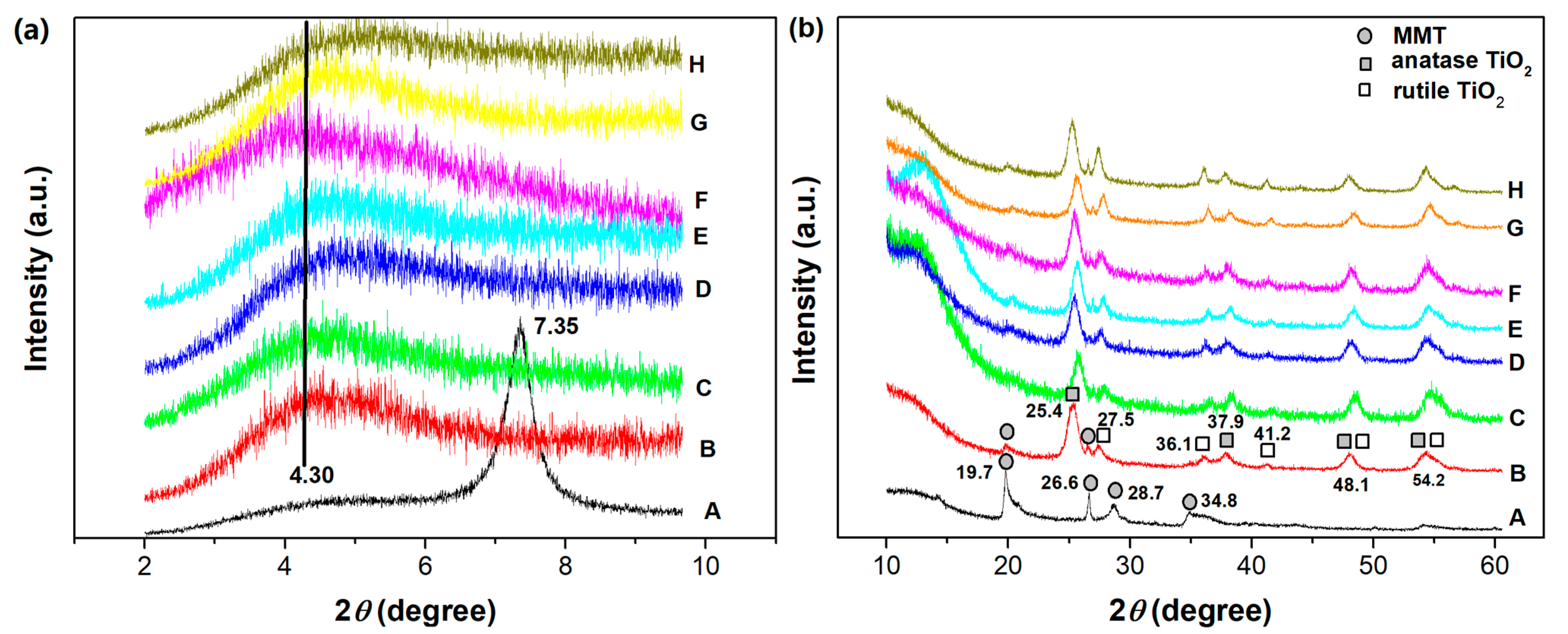


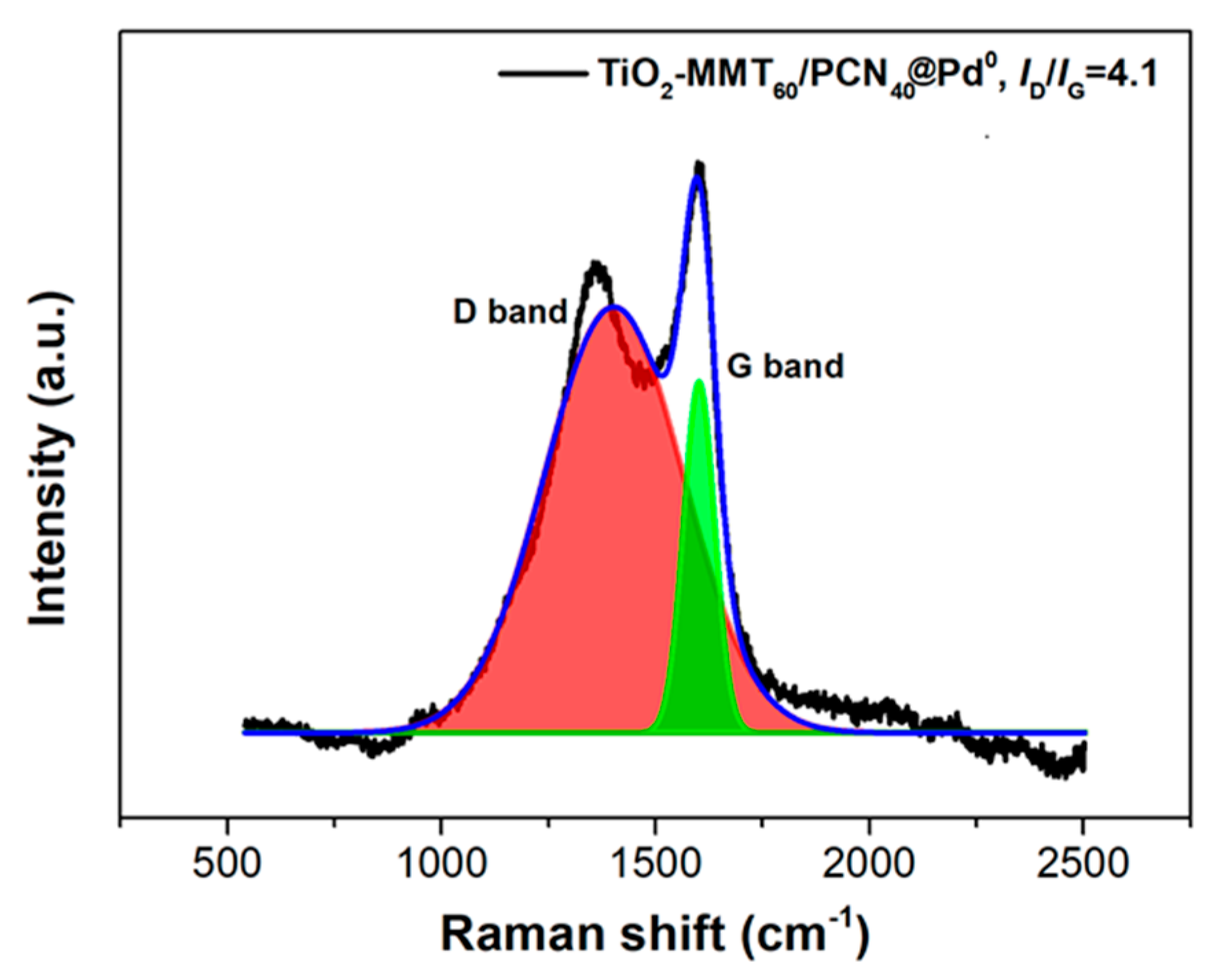

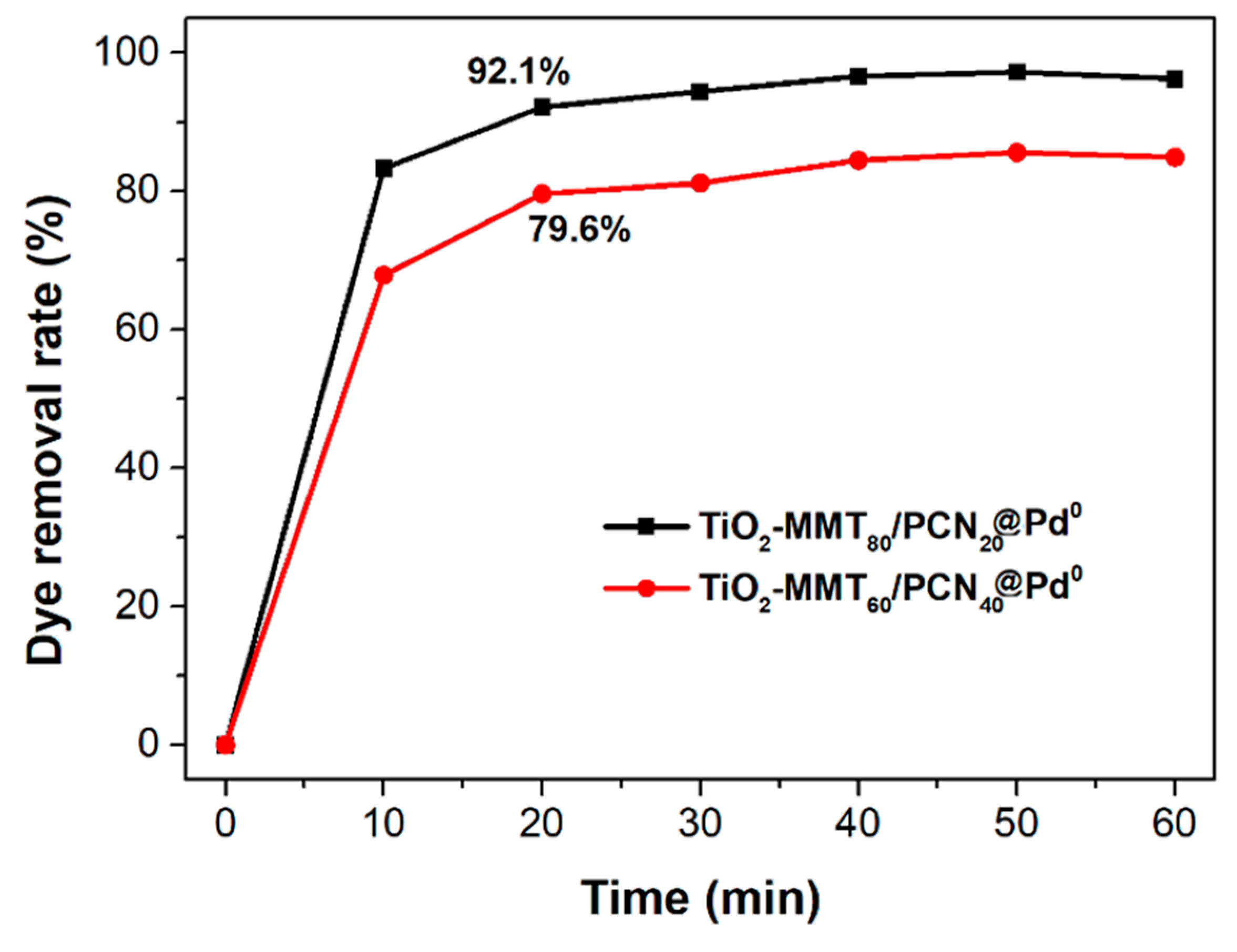

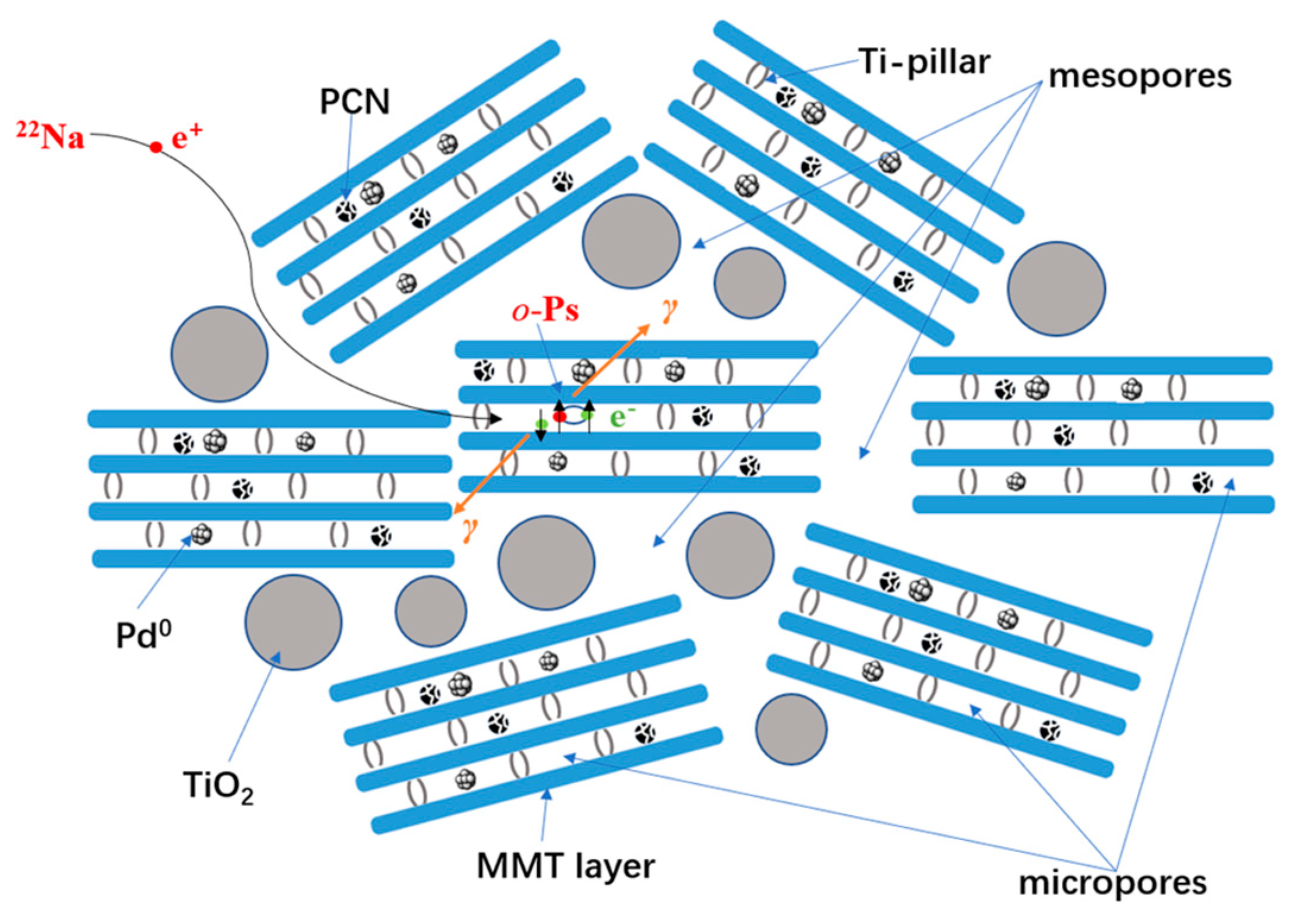
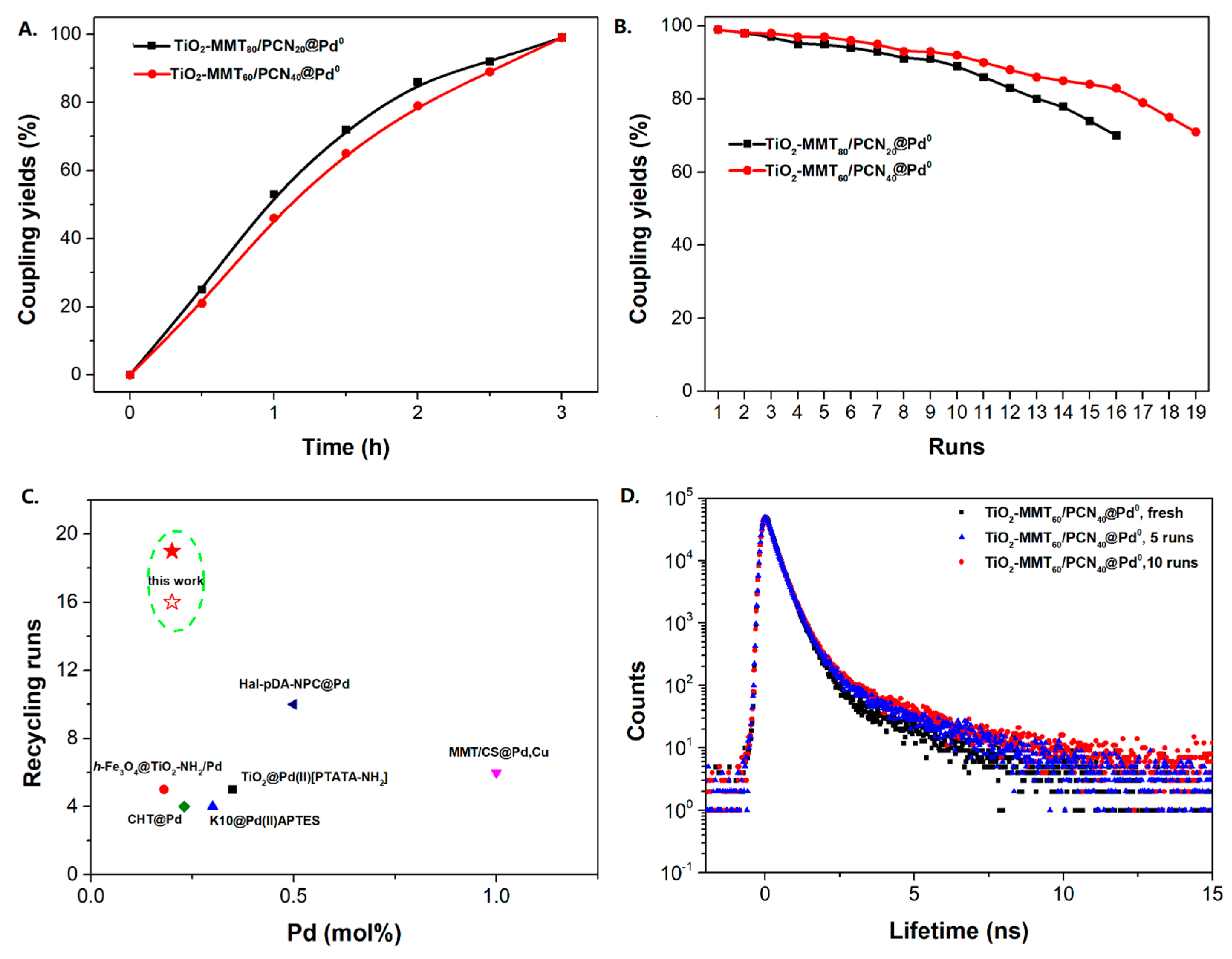
| Sample | SBET (m2/g) | Amic (m2/g) | Vtot (cm3/g) |
|---|---|---|---|
| MMT | 11.6 ± 2.1 | 2.8 ± 0.5 | 0.04 ± 0.01 |
| TiO2-MMT | 161.1 ± 13.6 | 49.5 ± 6.7 | 0.37 ± 0.01 |
| TiO2-MMT80/PCN20 | 137.3 ± 12.9 | 42.5 ± 7.2 | 0.37 ± 0.01 |
| TiO2-MMT80/PCN20@Pd2+ | 114.9 ± 11.5 | 32.7 ± 5.8 | 0.36 ± 0.01 |
| TiO2-MMT80/PCN20@Pd0 | 108.9 ± 10.6 | 31.2 ± 5.7 | 0.27 ± 0.01 |
| TiO2-MMT60/PCN40 | 124.2 ± 11.2 | 35.3 ± 6.2 | 0.33 ± 0.01 |
| TiO2-MMT60/PCN40@Pd2+ | 121.1 ± 12.3 | 38.7 ± 6.9 | 0.30 ± 0.01 |
| TiO2-MMT60/PCN40@Pd0 | 89.6 ± 10.6 | 15.7 ± 7.1 | 0.35 ± 0.01 |
| Sample | τ1 (ns) | I1 (%) | τ2 (ns) | I2 (%) | τ3 (ns) | I3 (%) | l (nm) | fapp(%) |
|---|---|---|---|---|---|---|---|---|
| MMT | 0.247 (2) | 57.4 (7) | 0.486 (4) | 40.0 (6) | 2.238 (3) | 2.6 (2) | 0.290 | 0.063 |
| TiO2-MMT | 0.239 (2) | 56.1 (7) | 0.438 (6) | 41.9 (8) | 2.398 (3) | 1.9 (2) | 0.307 | 0.055 |
| TiO2-MMT60/PCN40 | 0.243 (2) | 56.8 (7) | 0.433 (6) | 41.3 (9) | 2.440 (4) | 1.9 (2) | 0.311 | 0.057 |
| TiO2-MMT60/PCN40@Pd2+ | 0.222 (2) | 51.2 (7) | 0.434 (6) | 41.3 (8) | 2.409 (3) | 3.5 (3) | 0.308 | 0.102 |
| TiO2-MMT60/PCN40@Pd0 | 0.224 (2) | 57.4 (7) | 0.421 (6) | 39.6 (8) | 2.331 (4) | 3.0 (2) | 0.299 | 0.080 |
| Sample | τ1 (ns) | I1 (%) | τ2 (ns) | I2 (%) | τ3 (ns) | I3 (%) | τ4 (ns) | I4 (%) | l (nm) |
|---|---|---|---|---|---|---|---|---|---|
| Cf | 0.249 (2) | 71.3 (9) | 0.372 (4) | 8.8 (6) | 0.472 (4) | 18.0 (5) | 2.11 (6) | 1.9 (2) | 0.277 |
| C5 | 0.216 (2) | 54.0 (8) | 0.407 (4) | 42.6 (7) | 2.13 (5) | 3.1 (3) | 7.20 (8) | 0.3 (1) | 0.279, 0.616 |
| C10 | 0.211 (2) | 50.3 (8) | 0.413 (4) | 45.5 (7) | 2.08 (5) | 3.6 (3) | 8.7 (8) | 0.6 (1) | 0.274, 0.681 |
 | |||
|---|---|---|---|
| Entry | Aromatic Halides | Alkynes | Yield (%) a |
| 1 |  |  | 99 |
| 2 |  |  | 92 |
| 3 |  |  | 98 |
| 4 |  |  | 97 |
| 5 |  |  | 93 |
| 6 |  |  | 96 |
| 7 |  |  | 99 |
| 8 |  |  | 68 |
| 9 |  |  | 59 |
| 10 |  |  | 62 |
| 11 |  |  | 70 |
| 12 |  |  | 72 |
| 13 |  |  | 99 |
| 14 |  |  | 97 |
Disclaimer/Publisher’s Note: The statements, opinions and data contained in all publications are solely those of the individual author(s) and contributor(s) and not of MDPI and/or the editor(s). MDPI and/or the editor(s) disclaim responsibility for any injury to people or property resulting from any ideas, methods, instructions or products referred to in the content. |
© 2023 by the authors. Licensee MDPI, Basel, Switzerland. This article is an open access article distributed under the terms and conditions of the Creative Commons Attribution (CC BY) license (https://creativecommons.org/licenses/by/4.0/).
Share and Cite
Chen, Y.; Sun, K.; Zhang, T.; Zhou, J.; Liu, Y.; Zeng, M.; Ren, X.; Feng, R.; Yang, Z.; Zhang, P.; et al. TiO2-Modified Montmorillonite-Supported Porous Carbon-Immobilized Pd Species Nanocomposite as an Efficient Catalyst for Sonogashira Reactions. Molecules 2023, 28, 2399. https://doi.org/10.3390/molecules28052399
Chen Y, Sun K, Zhang T, Zhou J, Liu Y, Zeng M, Ren X, Feng R, Yang Z, Zhang P, et al. TiO2-Modified Montmorillonite-Supported Porous Carbon-Immobilized Pd Species Nanocomposite as an Efficient Catalyst for Sonogashira Reactions. Molecules. 2023; 28(5):2399. https://doi.org/10.3390/molecules28052399
Chicago/Turabian StyleChen, Yuli, Kailang Sun, Taojun Zhang, Jie Zhou, Yonghong Liu, Minfeng Zeng, Xiaorong Ren, Ruokun Feng, Zhen Yang, Peng Zhang, and et al. 2023. "TiO2-Modified Montmorillonite-Supported Porous Carbon-Immobilized Pd Species Nanocomposite as an Efficient Catalyst for Sonogashira Reactions" Molecules 28, no. 5: 2399. https://doi.org/10.3390/molecules28052399
APA StyleChen, Y., Sun, K., Zhang, T., Zhou, J., Liu, Y., Zeng, M., Ren, X., Feng, R., Yang, Z., Zhang, P., Wang, B., & Cao, X. (2023). TiO2-Modified Montmorillonite-Supported Porous Carbon-Immobilized Pd Species Nanocomposite as an Efficient Catalyst for Sonogashira Reactions. Molecules, 28(5), 2399. https://doi.org/10.3390/molecules28052399









